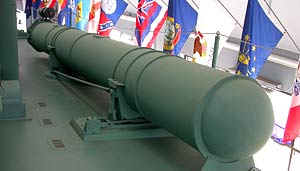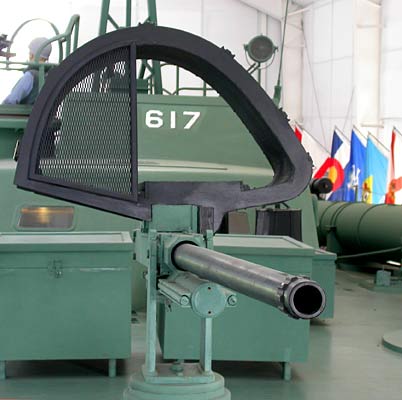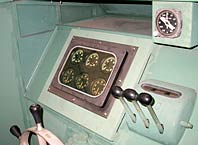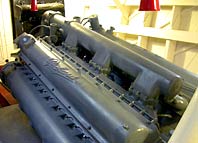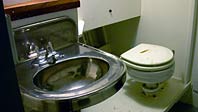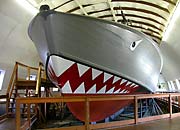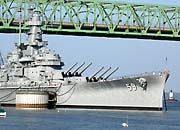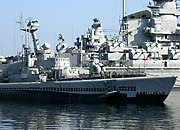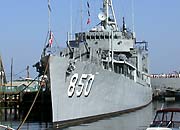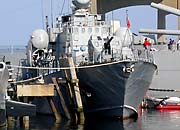
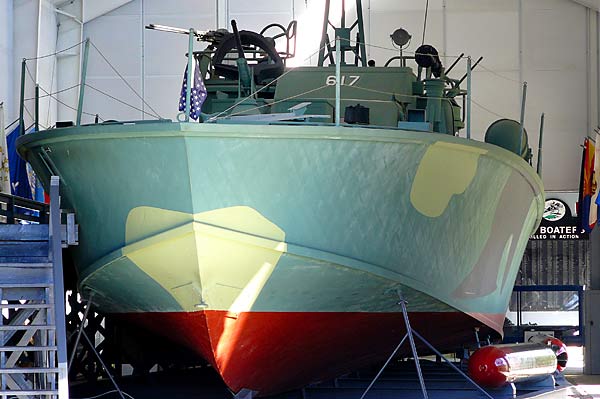 |
|
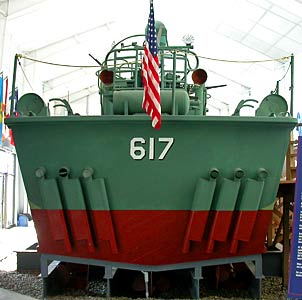 |
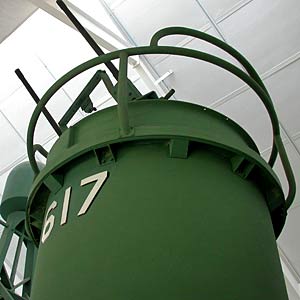 |
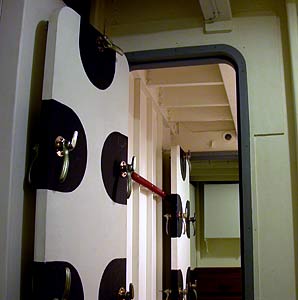 |

PT Boat PT-617 (Elco)
PT-617 is an Elco class PT Boat. PT-617's specifications are:
Length: 80 feet
Beam: 19 feet 11 inches
Draught: 4 feet
Crew: 2 officers and 9 crewmen
Displacement: 51 tons fully loaded
Max Speed: 41kts (46mph)
Fuel Capacity: 3,000 gallons of 100 octane avgas
Range: 358 miles at 35kts, 1050 miles on one engine, 11 knots
Oil Capacity: 30 gallons
Armament:
4 21" Torpedoes
Up to 8 Mark 6 300 pound Depth Charges
1 37mm Deck Gun
1 40mm Bofors AA mount aft
4 50 cal. Browning Machine Guns
Hull Construction: Double planked Mahogany (NOT plywood)
Power Plant: 3 1,200 hp Packard V-12 marine engines driving 3 propellers with 3 rudders
Launching Date: September 21, 1945
You can visit this Elco PT Boat PT-617 at the Battleship Cove Naval Museum in Fall River, MA. This PT Boat (Patrol Torpedo) had been sent to a professional ship yard for a complete restoration and has been completed to a very high standard. If you have ever seen a PT Boat in a movie or on TV be prepared, it is a lot larger in real life! The restoration is very well done and the only issues I could find with the exterior were the lack of actuators for the valve flaps which either routed the exhaust through the mufflers for quiet running or directly out the ports for high speed runs. One thing I and two PT Vet friends are wondering is what is the purpose of those black semi circular areas around the door latches. One veteran of PT Boats felt it was to keep the grime from dirty hands from showing. I am guessing that it was to make the handles stand out at night or if the PT Boats capsized to aid the crew in escaping. If you have served on or been involved in the construction of Patrol Torpedo Boats and know the answer, send me a note. I'd love to hear it.
Early in the war the crews of the PT Boats found that their torpedoes didn't detonate, even when they were certain they were aimed accurately and should have hit their mark. Unfortunately their reports fell upon deaf ears. The torpedo suppliers denied there were any problems with their fish and the brass felt the commanders were just missing their target ships. It took about 2 years before the torpedoes were tested in real world conditions. The findings were that the torpedoes ran 10 to 15 feet deeper than set, that magnetic fuses did not go off when they should, and the striker for the contact fuse would snap upon impact if the torpedoes struck the target at any angle other than 90 degrees to the surface they struck, preventing the detonation of the warhead. Once this problem was addressed and resolved, the PT Boats and especially the fleet submarines were much more successful in their torpedo attacks.
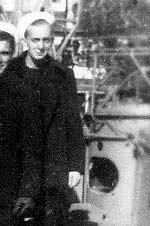 |
Jack Madden, PT Boat Veteran of the Mediterranean Theater |
I was fortunate to get an invitation from PT Boat Veteran Jack Madden to go on board the PT-617 to get the shots for this web gallery. I really wanted to give people a feel for what the interior of these boats was like. There is surprisingly a lot of room. My father served on a Destroyer Escort and this boat seemed to have much more room per person. And the heads were much more civilized and had genuine privacy. The vets I spoke to that served in the Pacific said they did not sleep on the PT Boats so they didn't store much inside in the way of gear. The crews would go out at night to seek out the enemy and then returned to the base at dawn.
When we were in the engine room I asked Jack about the controls to the Packard V12 engines. I wanted to know how much direct control the commander had or whether he would have to call down to the engine room to make power changes. Jack's answer was that the commander on the bridge had direct control over the throttles, but did not have control over the engagement of the transmission to the propeller shaft or forward and reverse gears (In order to engage forward, reverse, or idle the commander had to call down to the engine room where the operator manipulated the gear shift levers for each engine and propeller manually). Jack said that was John F. Kennedy's problem the night PT 109 was rammed and sunk by a Japanese destroyer. PT 109 was idling in neutral on a very dark night. Lieutenant Kennedy heard the Japanese Destroyer Amagiri bearing down on them but did not realize it was on a collision course with PT 109 until it was very close as the night was pitch black with no moon. When JFK realized that the collision was imminent, he immediately called for the transmission to be engaged by the engine room operator but it was too late. Kennedy could not power the boat out of the way in time to avoid being rammed and split in two by the Japanese Destroyer. Whether those extra few seconds of transmission engagement lag time made the difference between the Amagiri cutting PT 109 in half or not will never be known, but it might have. Jack mentioned that from the time of the sinking of Kennedy's boat onwards it became standard procedure to keep the transmissions engaged when idling at night in enemy waters to prevent such an incident from happening again.
Jack served on Higgins PT Boats in the Mediterranean. He told me a few stories but my favorite was a story about beer. While their PT Boats were moored in a small port in the Mediterranean a large quantity of beer was unloaded on the pier right in front of them. Unfortunately it was guarded by MPs as the beer was destined for the brass and the crews were not to get any of the brew. However Jack's and the other crews were a smart bunch. The men concluded a distraction was in order. Two of the men headed down to the end of the pier. When the two crewmen were sure the MPs could see them they engaged in a very loud and physical fight. Upon seeing the altercation the MPs ran off from their beer guard duty to stop the fight and while they were distracted the remainder of the crews made off with several cases of the beer and hid them in their PT Boats.
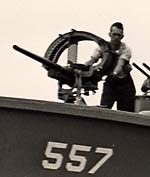 |
Milt Donadt, PT Boat Vet of the Pacific Theater |
A friend of my father, Milt Donadt served on Elco PT Boats in the Pacific during the Second World War. Although personal cameras were not officially allowed Milt brought a Kodak Brownie camera with him and took a number of photos of life on a PT Boat base in the Solomon Islands. Click on the link to the left to have a look at them. Some of the photos are really quite interesting. Milt served as a bow gunner on the 37mm cannon (the same weapon firing through the propeller of the Bell P-39 Airacobra). I thought, man that's a pretty vulnerable position on the boat and asked him why he chose it. Milt said he figured if the boat was hit and blown up he would be blown off the boat and would have likely survived. Another thing he said that amazed me was that they never wore any kind of hearing protection. Which is so amazing as Milt is well into his 80s and still hears very well. Milt even got shots of sailing the PTs through the locks north of the Hudson to get several examples from Melville RI to Detroit, MI. Shortly after the war's end Milt volunteered with a group of other PT Boat crewmen to ferry a group of boats up to Detroit to display for the public. Milt said that when they got there they got chewed out by some admiral. Apparently they motored their PT Boats up the Hudson at full throttle and the wakes damaged a number of the docks along the Hudson's river banks. The return trip back down the Hudson River was not quite as much fun as their high speed run north.
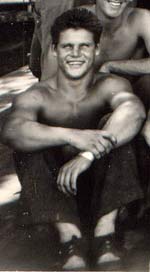 |
WWII PT Boat Veteran Charles Nelson |
One of Milt's fellow crew members, Charles Nelson wrote an in interesting account of his experiences as a 50 caliber Browning Machine Gun Turret Gunner. It was featured in the PT Boat publication, "All Hands" and has been posted here with permission.
One interesting thing about the Patrol Torpedo Boats is the way they are constructed. Although often referred to as "Plywood Boats" and sometimes "Mosquito Boats", the hulls of the PT Boats were actually constructed of double planked mahogany. Look closely at the hull photo above and you will see the diagonal outer layer of planks. The inner layer of planks is laid at an opposite direction diagonally making the hull very strong. I believe there is a layer of glue impregnated canvass between the two layers of planks to enhance the water tightness of the hull. Actually there is some plywood used in the these boats. I found it in the construction of some of the cabinetry of the Higgins that is displayed in the same building just behind the Elco PT Boat.
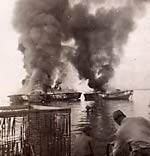 |
Burning the PT Boats at the end of World War II |
Sadly at the end of the war the PT Boats still left in the Solomon Islands were burned to the water line. Before the hulls were burned they were stripped of engines and armament. I would have thought they would have left the boats for the natives. There was plenty of usable building lumber on each Elco and the locals could have made good use of the materials. There is a LOT of lumber in an 80 foot Elco PT Boat! When I asked Milt about why they were burned, he replied the boats had taken a beating from all the night missions they performed (and some had run aground and had been repaired) and also that they just didn't care. The war was over and they just wanted to get home.
Battleship Cove Naval Museum is an awesome naval museum. If you go allow yourself a full day as there is an awful lot to see in addition to the Patrol Torpedo Boats. There is the Destroyer USS Joseph P. Kennedy DD-780, the Submarine USS Lionfish SS-298, the Soviet Missile Corvette Hiddensee, and the Battleship USS Massachusetts, BB-59. Although I didn't do so myself, I learned that you can actually stay overnight on the Battleship Massachusetts. The next time I go I'll try to book myself a bunk onboard the ship to save myself that long drive back to NJ at the end of the day. It would have been pretty neat to be there at Sunset and Sunrise. They even had a grill/snack bar on board with food that was quite passable and reasonably priced. I honestly remember it as being pretty darned good, but then I was starved after spending the morning tramping about the other naval vessels on exhibit at the Battleship Cove.
Other Battleship Cove Naval Museum Exhibits |
|
|||||
